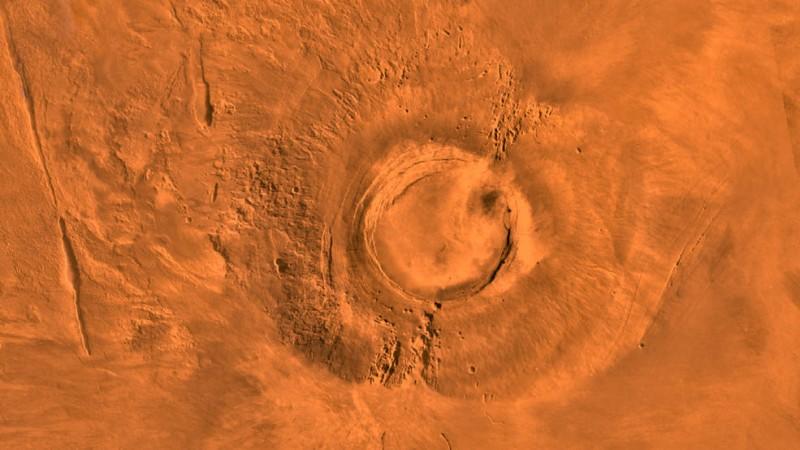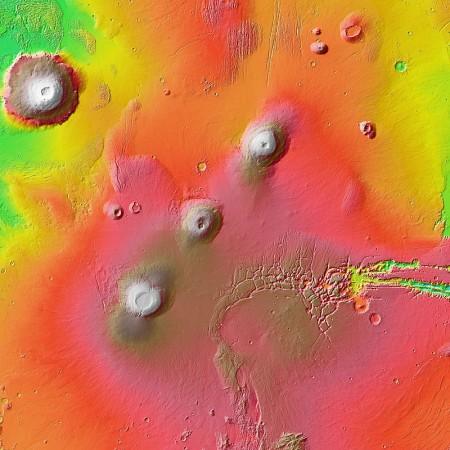
NASA has revealed new information on the giant Martian volcano Arsia Mons. It's been found that the volcano became inactive around the same time the dinosaurs became extinct on Earth.
Also Read: UFOs spotted: Two mysterious craft have been spotted passing by the ISS, again! [VIDEOS]
Arsia Mons is a part of the Martian volcanic trio called Tharsis Montes, which comprises Ascraeus Mons, Pavonis Mons and Arsia Mons. "Mons" stands for mountain in Latin.

Arsia Mons is the southern-most volcano on the Red planet. According to an official NASA statement, the volcano took billions of years to form.
NASA researchers used computer models to try and find out when the volcano went dormant. It was found that the volcano turned dormant 50 million years ago, when the Earth's Cretaceous–Paleogene extinction event took place.
When Arsia Mons was active it used to produce a lava flow at its summit once every 1 to 3 million years.
"We estimate that the peak activity for the volcanic field at the summit of Arsia Mons probably occurred approximately 150 million years ago—the late Jurassic period on Earth—and then died out around the same time as Earth's dinosaurs," said Jacob Richardson, a postdoctoral researcher at NASA's Goddard Space Flight Center in Greenbelt, Maryland.
"It's possible, though, that the last volcanic vent or two might have been active in the past 50 million years, which is very recent in geological terms," Richardson added.
According to researchers, the latest volcanic activity took place in the Red Planet's caldera, which is a bowl-shaped depression. Researchers spotted up to 29 volcanic vents in this region of Mars; it is difficult, however, to specify the exact time period when this volcanic field was last active.
Researchers acquired high resolution images of the caldera through the Context Camera on NASA's Mars Reconnaissance Orbiter and found that the caldera spread over an area of 110 kilometres (18 miles) and can hold as much water as Lake Huron — 59,600 km² (23011.689 mile²)
"The team mapped the boundaries of the lava flows from each of the 29 volcanic vents and determined the stratigraphy, or layering, of the flows. The researchers also performed a technique called crater counting—tallying up the number of craters at least 330 feet (100 meters) in diameter—to estimate the ages of the flows," a NASA statement revealed.
A new computer model, devised by Richardson and his colleagues at the University of South Florida, was used; they combined the information they acquired by counting the number of craters and the mapped lava flows in order to find out when the last volcano was active.
The researchers revealed that the last volcanic activity took place around 10 to 90 million years ago, while the oldest flow is estimated to have occurred around 200 million years ago.
Researchers estimate that around 150 million years ago, the vents in the Arsia Mons' caldera produced around 1 to 8km3 of magma once every million years, increasing the size of the volcano.
"Think of it like a slow, leaky faucet of magma," said Richardson. "Arsia Mons was creating about one volcanic vent every 1 to 3 million years at the peak, compared to one every 10,000 years or so in similar regions on Earth," he explained.
This research has goven scientists much-needed insights into Mars' interior structure and history.
"A major goal of the Mars volcanology community is to understand the anatomy and lifecycle of the planet's volcanoes. Mars' volcanoes show evidence for activity over a larger time span than those on Earth, but their histories of magma production might be quite different," said Jacob Bleacher, a planetary geologist at Goddard and a co-author on the study.
"This study gives us another clue about how activity at Arsia Mons tailed off and the huge volcano became quiet."
These findings were presented by Richardson at the Lunar and Planetary Science Conference in The Woodlands, Texas on March 20, 2017. The research has been published in the journal Earth and Planetary Science Letters.







!['Lip lock, pressure, pyaar': Vidya Balan- Pratik Gandhi shine in non-judgmental infidelity romcom Do Aur Do Pyaar [ Review]](https://data1.ibtimes.co.in/en/full/797104/lip-lock-pressure-pyaar-vidya-balan-pratik-gandhi-shine-non-judgmental-infidelity-romcom.jpg?w=220&h=138)








